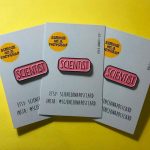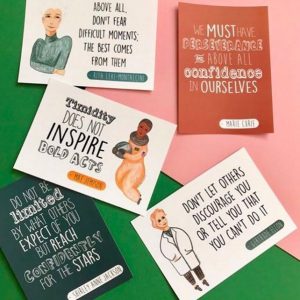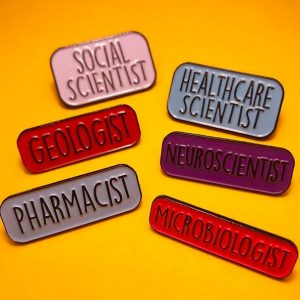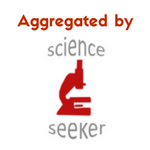Farah Qaiser is a graduate student at the University of Toronto, where her research involves whole-genome sequencing of patients with neurological disorders. When not in the lab, Farah dabbles in various science communication, policy and outreach initiatives. You can find Farah live-tweeting Toronto’s many science events at @this_is_farah or speed-reading (yet another) dystopian novel on her commute home.

Dr. Gardner is known for her signature “Scientist” pink enamel pin

Dr. Heidi Gardner is exploring science blogging practices through a WCMT fellowship
In early January, Toronto played host to the U.K.’s Dr. Heidi Gardner as she met with various scientists and science communicators across the city, in her mission to explore the process and practice of science blogging, as a part of her Winston Churchill Memorial Trust (WCMT) fellowship
Each year, the WCMT fellowship allows individuals to travel overseas to learn more about strategies to tackle problems facing the U.K. Last year, there were 1,096 applications and Heidi emerged as one of the 150 fellowship winners. In particular, it was Heidi’s unique combination of research into health services, running a successful science-themed Etsy shop, and prior science communication experiences that made her stand out.
Heidi’s research career didn’t begin in the field of health services. She was initially studying pharmacology before she took a year off to gain work experience. Instead of working in a lab, Heidi chose to pursue an industrial placement at a staffing agency oriented to clinical trials.
“It was the steepest learning curve of my life,” says Heidi. “It was terrifying, but really good.”
There, Heidi learned that clinical trials were not perfect. She soon picked up on inefficiencies and holes in trial methods, and decided to head back to graduate school to explore the field of health services instead. Heidi started a PhD in Applied Health Sciences at the University of Aberdeen, in the north of Scotland, where her focus has been on exploring how to improve the efficiency of clinical trials, especially when it comes to participant recruitment.
In late 2017, Heidi attended a meeting at the National Institute for Health Research in England, and flew home that same day. A fellow passenger noted her short trip and asked her what she had been doing in the city. When Heidi explained that she was a scientist, the passenger looked surprised and said: “Oh, you don’t look like a scientist.”
The stranger’s offhand reply bothered Heidi. She spent the flight home thinking about it. How could she immediately signal to strangers that she was a scientist?
Fortunately, an idea came to mind almost immediately.
By the time her plane touched down in Aberdeen, Heidi had created an Etsy shop and relevant social media channels for her new idea: Science On A Postcard. Her main objective was to create things that people could wear or use to mark them as a scientist.

Heidi partnered with Nina Chhita to release a set of postcards to celebrate women in science
“I feel like there are members of the public who don’t realize that there are scientists who walk among us,” says Heidi with a laugh. “We’re one of you
At first, the Science On A Postcard Etsy shop included four postcard designs only. She expanded to include enamel pins and is now known for her signature “Scientist” pink enamel pin (see image above).
Since then, Heidi has also collaborated with other science artists to launch new products. For example, she collaborated with Nina Chhita (from Nina Draws Scientists) to release a set of postcards featuring women in science in time for the International Day of Women and Girls in Science (February 11, 2019). Heidi’s passion for science engagement even inspired her mother, also an Etsy shop proprietor, to introduce new science-themed merchandise in TeddyPerkins, including a popular badge which states “It’s Dr. actually.”
In addition to completing her PhD and running an online business, Heidi has continued to explore science communication and public engagement projects. For example, she gives talks to the public and brought the global Soapbox Science initiative to Aberdeen (for the first time!). She continues to blog and, if you read this post about artist-scientists, you can see the University of Toronto’s talented Jen Ma featured.
Along with her successes, Heidi has also learned a few lessons.
“Everything takes 400 times longer than you ever think it’s going to,” says Heidi.
For anyone interested in launching a similar initiative or any side-hustle alongside their PhD, Heidi recommends to thoroughly prepare for it. For Heidi, her idea was sudden.
“I didn’t give myself enough time to build up stock and inventory. I think that my abilities stunted [the shop’s] growth and it could have been a lot bigger than what it is. I could make the shop a career, but I don’t want to, so I’ve kept it small,” says Heidi. But for people who want this, Heidi suggests building inventory for three to four months because time tends to disappear quickly when running an online business.
Currently, as a WCMT fellow, Heidi’s project is titled: “Putting pants on the truth; improving practice of UK sci-bloggers.” As detailed in a recent blog post, Heidi plans to explore why scientists are blogging, how science communicators are engaging the public, and measuring the impact of such efforts.
Her first stop was in Toronto, where she met with individuals such as Samantha Yammine (science communicator and Signals blogger), Ryerson University’s Dr. Imogen Coe, Mount Sinai Hospital researcher Dr. Jim Woodgett and Dr. Victoria Forster (SickKids researcher and Forbes writer), among others.
While Heidi will release her findings as a report following her travels, she shared what she had learned from Toronto scientists and science communicators. Heidi notes that while science communication is important, it’s not being valued as much as it should be as a lot of women are currently doing it. She points out issues, such as a lack of resources for training and support, have come up repeatedly in conversations. For example, if your work is plagiarized, what do you do? If it were a case of manuscript plagiarization, you would report it to the journal, but in the science communication field, there is no equivalent.
Heidi’s fellowship is sending her to the U.S. next and, in the remaining weeks, she will also head to Singapore and Hong Kong for more insight into science blogging, before returning to the University of Aberdeen in March as a Research Fellow. While I excitedly await her final report for insights into global science blogging, I’ve taken the liberty of ordering her “Science Communicator” pin for my collection.
And yes, Heidi’s Etsy shop is still open (thanks to her Mom) and still shipping all the science-themed merchandise you (desperately) need as Heidi learns more about improving science blogging practices from around the world.

Guest
Latest posts by Guest (see all)
- Regenerative immunotherapy: Hope for chronic autoimmune diseases - September 16, 2025
- Canada’s regenerative revolution: Why AI is the catalyst - September 4, 2025
- Summer by Design: A launchpad for future entrepreneurs and industry scientists - August 14, 2025






Comments